The Commonwealth War Graves Cemetery
Pune (Poonah) India
These are photographs taken at the Commonwealth War Graves Cemetery in
Pune (Poonah) India in November 2000.
A few comments about Pune:
Pune -- a modern spelling created by a nationalistic desire to return
things to pre-British times -- a little hard to fathom as the local alphabet is completely
different!. The desire falls short of achievement and you will still find the name spelled
'Poonah' in such places as the airline waiting line. Most Indians are little interested in
the attempt to rename things and still use the names that were in place during the British
Raj.
Pune is located inland from the port of Bombay (now called Mumbai -- there
was virtually nothing there before the British created a trading port) about 140
kilometers and with an increase in elevation of about a thousand meters. It is a twenty
minute flight from Bombay or about four hours by road (the new motorway may speed that
up). It is a fairly large city with a large university and highly educated population.
The city has a few good hotels and I can recommend Le Meridien or the
Holiday Inn both of which cost about $100/day when you include meals. These hotels are
within a few blocks of each other and about 20 minutes from the airport by taxi -- if you
are staying at one of these hotels they will arrange to pick you up. As you probably know,
in this part of the world, do not drink the water or eat uncooked food. Do not expect to
eat beef. As near as I could tell you can eat almost anything else as long as it is
chicken and rice in some variation or other.
The city is the capital city of the province of Maharashtra. It dates from
about the 1400's making its founding comparable in time with Milan in Italy. On the
outskirts of the old city is the area known as Kirkee. It was the site of a significant
battle between the British and the Indians in 1817. The British had supported the Indian
prince in his attempt to retain power about a decade earlier. By 1817 he felt he could be
rid of the British. At that time the British had about 1,000 British troops and 2,000
Sepoys. The Indian army had about 30,000 troops. They met on the plains at Kirkee and the
Indian army was defeated which finalized the control of this part of India by the British.
Poonah became an important army town with many cantonments -- areas which still exist in
some ways today. Pune is the site of the Indian Defense College and many other military
installations.
The Commonwealth War Graves cemetery is a pleasant 20 minute drive from
the hotels, going along the river and through several military garrisons.
The Cemetery:
The cemetery is located about a 20 minute drive from the airport. The
memorial plaques and the role of honour are not generally available unless the
groundskeeper in attendance -- if you are wanting to see these you should probably expect
to spend a few hours waiting, unless you are lucky enough to arrive at a time when he is
there. On one occasion I visited in the morning and he was not in attendance. On a second
occasion, in the mid afternoon, he was there. He was most helpful in locating graves. I
had indicated an interest in the Canadian graves and we were able to find seven of the
eight that were indicated to be there. He was also concerned that I see the grave of the
lone American buried in the cemetery.
I unfortunately have lost some of the photographs that I took -- I was
having some difficulty with my camera and later had a computer stolen (not in India, in
Holland) and between those two problems I have only three particular grave photographs
remaining.
A Description of the Cemetery from the Commonwealth War Graves
Commission plaque
Kirkee War Cemetery
Index Number Ind. 13
Kirkee, also known as Khadki, is a pleasant military cantonment adjoining
the large town of Poona on the plateau above Bombay. It is reached by train from Bombay to
Poona, a journey of about four hours, and from Poona station Kirkee is ten minutes by
taxi.
The war cemetery occupies an attractive site on the banks of the Mula
river. From the entrance gates in Mula road broad, shallow steps lead down into the
cemetery, which is some five feet below the road level. The banks on either side of the
steps are clothed with ornamental and flowering shrubs and the avenues leading to the
Cross of Sacrifice are formed by Peltophorum trees which twice a year bear beautiful,
sweetly scented yellow flowers. Across the site stretch pergolas covered with flowering
climbers -- bignonia, alamanda and bougainvillea -- and the various seats in the cemetery
are shaded by flamboyants or gold mohur trees. The headstone borders contain dwarf roses
and hybrid tea roses, and the whole area, save for paths, is turfed.
At the opposite end of the cemetery, opposite the entrance, is a large
memorial commemorating 193 East and West African soldiers of the 1939-1945 War and 1170
soldiers of the 1914-1918 War who are buried in many parts of India and Pakistan where
there graves are either unlocated or so situated that maintenance is not possible.
This cemetery is purely a concentration cemetery, and there are gathered
together war graves from the western and central parts of India where permanent
maintenance could not be ensured. The total number of burials is 1,674 classified as shown
opposite. In addition, special memorials commemorate two 1939-1945 War casualties of the
merchant navy who are buried elsewhere.
The register of the 1939-1945 War casualties commemorated on Kirkee
Memorial is included in this volume. The names of the 1914-1918 casualties are the subject
of a separate register.
The Photographs.
The remaining photographs that I have are shown below with comments. Note
that the thumbnails shown here are distorted. Each thumbnail has a hyperlink to a full
size copy of the photograph.
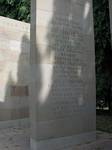
A memorial to the war dead of World War I |
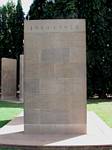
Another memorial the World War I war dead |
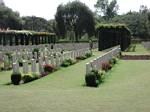
A view of part of the cemetery |
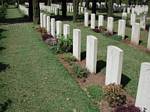
A general view of the cemetery with a row of Air Force graves in the
foreground. |

This photograph shows the graves of several crew members and Indian
passengers who were killed in a plane crash. The only discernable name is that of WO
O'Brien. It may be that all crew members were British or it may have been that one was a
Canadian. I took the photograph as an example of how one crash might kill many
individuals, but may also have taken it because one was a Canadian crew member |
| 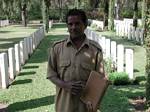
A photograph of the groundskeeper employed by the Commonwealth War
Graves Commission. He is holding the memorial role which, because of the way things are in
India, is not left on site when he is not there. |
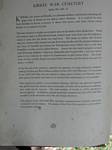
A description of the Kirkee Cemetery |
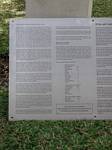
A page from the memorial plaques at the cemetery. This page is blown up
in the following photographs |
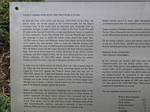
A statement on the role of Indian soldiers in the two world wars. Over
160,000 Indian soldiers lost their lives. |

A partial view of the commemorative narrative |
| |
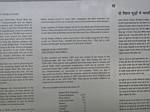
A partial view of the commemorative narrative |
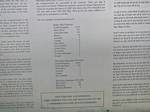
A summary of the war casualties honoured at the cemetery. It shows 8
Canadian personnel from World War II who are buried there. All of these were R.C.A.F. and
one World War one Canadian who is commemorated on the tablet |
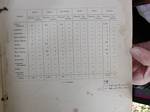
A table which lists the numbers of war dead by nationality and service |
|
| |
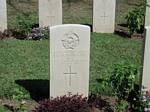
The grave of
R.80922 Warrant Officer 1
R.G. McIntaggart, Pilot
Royal Canadian Air Force
who died 31st July, 1943 |

The grave of
Flight Lieutenant H.C. Morgan
Royal Canadian Air Force
who died 10 July, 1945
The inscription is not clearly recorded but appears to be:
"At the going down of the sun we shall remember them"
I believe F/L Morgan was from Toronto |
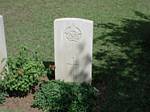
The grave of
Flying Officer S.D. Woodman, pilot
Royal Canadian Air Force
who died 17 August 1945, age 22
The inscription reads:
"In Loving Memory
May God be with you . . ." |
|